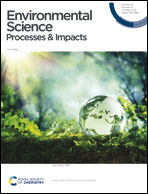Impact of atmospheric anthropogenic nitrogen on new production in the northern Indian Ocean: constrained based on satellite aerosol optical depth and particulate nitrogen levels
Abstract
Aerosols are one of the significant external sources of soluble reactive nitrogen to the surface ocean and their deposition affects the primary productivity. Owing to rapid industrialization over South and Southeast Asia, an increasing trend in atmospheric pollutants was observed over the northern Indian Ocean (NIO). To assess the contribution of the aeolian supply of inorganic nitrogen to the NIO, the available compositional data of marine aerosols collected over this basin between 2001 and 2020 were compiled. Based on the observed relationship of mass load, and particulate nitrate and ammonium concentrations with the corresponding satellite-derived anthropogenic aerosol optical depth (AAOD), the temporal, spatial, and long-term variabilities were derived for the past two decades. In particular, high aerosol mass load, nitrate and ammonium levels were observed in the coastal aerosols of peninsular India during fall and winter and they were low in summer. The atmospheric input of inorganic nitrogen to the Arabian Sea is higher (AS; 1.7 TgN per year) compared to that of the Bay of Bengal (BoB; 0.9 TgN per year) and accounts for ∼30% of the total external sources of nitrogen to the NIO. The new production, supported by external sources of nitrogen, contributes to ∼23 and 53% of export production to the oxygen minimum zone (OMZ) in the AS and BoB respectively. A significant rate of increase in the aerosol mass load (0.05–1.67 μg per m3 per year), and nitrate (0.003–0.04 μg per m3 per year) and ammonium (0.006–0.11 μg per m3 per year) concentrations was observed between 2001 and 2020, likely because of the increased emission of anthropogenic pollutants over South and Southeast Asia and their subsequent long-range atmospheric transport to the NIO. Overall, these results suggest that an enhanced contribution of atmospheric nitrogen may potentially increase (1) the N/P ratio of the surface ocean that impacts phytoplankton composition, (2) export production to the OMZ leads to intensification, and (3) sequestration of atmospheric CO2. A decrease in primary production due to global warming is reported due to a decrease in vertical nutrient supply; however, the increase in atmospheric deposition of nutrients may compensate for this. Therefore, ocean models must be coupled with atmospheric models to better constrain the oceanic response to climate change in the NIO.

- This article is part of the themed collection: Atmospheric chemistry


 Please wait while we load your content...
Please wait while we load your content...